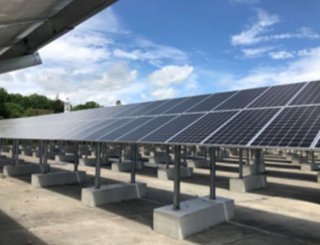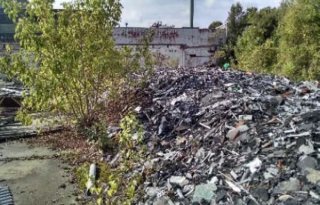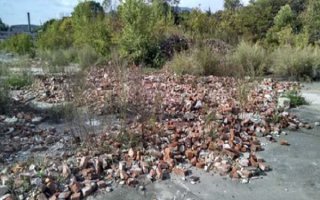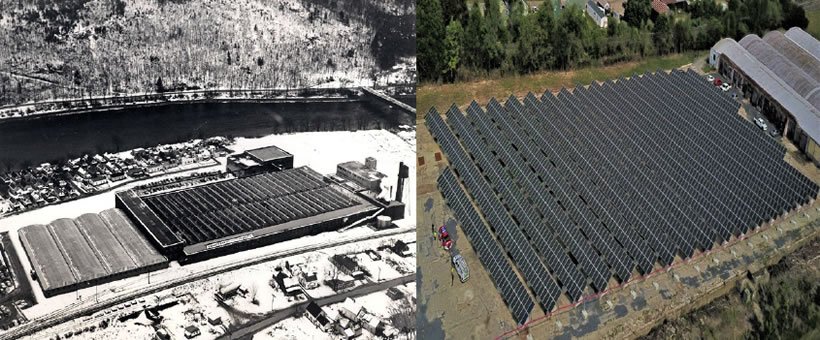R1 Success Story: Goodyear Industrial Campus, Windsor, Vt.

(photo credit: Mount Ascutney Regional Commission)
EPA Grant Recipient:
Mount Ascutney Regional Commission
Grant Types:
Revolving Loan Fund
Current Use:
Solar Array
Former Uses:
Agriculture, Machine Tooling, Manufacturing, Light Commercial, and Industrial Space
Download Success Story:
Goodyear Industrial Campus, Windsor, Vt. (pdf)
An industrial site occupied for half a century by the Goodyear Tire and Rubber Co. in Windsor, Vt. is now host to a solar array providing 500 kilowatts of energy for the region at any given time, more if there is a battery component to the system. The EPA Brownfields revolving loan fund program played a key part in making this exciting project possible by providing financing for the environmental cleanup that was first needed at the site.
Site History
For 50 years, Goodyear Tire manufactured rubber shoe and sole parts in Windsor. During World War II, women took over many jobs at the plant and made Vermont a major supplier of boot soles for the nation’s military forces. At its peak, Goodyear employed nearly 1,000 workers in a community of 4,000 people.
Goodyear continued to operate in Windsor until the collapse of the manufacturing industry left the company with no choice but to permanently close its doors in 1986. Goodyear donated the 7.4-acre property to a local development corporation. Portions of the site have continued to be used by a variety of smaller commercial and industrial tenants, including cable manufacturing, tool shops, frame shops, woodworking, auto and truck repair, and warehousing.
The main manufacturing building on the site was nicknamed the “sawtooth building” for its roof-mounted skylight configuration, characteristic of many early 20th century mill buildings. Unfortunately, the sawtooth building remained mostly dormant and deteriorated over time and was demolished in the early 1990s for the value of its wooden beams, leaving behind a 4-acre concrete slab littered with tons of demolition waste and asbestos-containing materials.
Priming the Property for Redevelopment

(photo credit: Mount Ascutney Regional Commission)
Due to the site's location in a designated flood plain, long-term redevelopment options were limited. One of the primary options that local planners settled on was to use the building slab for a solar array. The site had significant sun exposure that would make for an ideal location. The basic concept was to have local businesses in turn purchase the renewable energy to power their facilities. As community support for this idea grew, a local public/private partnership formed to shape this into a reality.
The Mount Ascutney Planning Commission partnered with two nonprofit economic development organizations to fast track this project. One nonprofit, Windsor Improvement Corp., acquired the property in order to make the site eligible for EPA's brownfields cleanup funding, while the other, Springfield Regional Development Corp., provided key project management and economic development expertise and support. With these partnerships in place, the planning commission was then able to provide Brownfields cleanup funding in the form of a $150,000 grant and $250,000 loan to clean up the slab in preparation for the solar array. Over 2,000 tons of asbestos-contaminated building debris were removed from the site. For the project to be successful, all permitting had to be in place and the solar array needed to be completed and generating electricity before the end of the year to take advantage of energy credits. The project team met the deadline and successfully completed the cleanup.
Within days after the cleanup was finished, installation of the large solar array began. Design modifications added challenges. Among the challenges, all electrical connections had to be raised six feet above ground to protect the array during floods. The lease payments from the operator of the solar array will help pay off the cleanup loan and invest in the local businesses in this area.
"That was a great project because it enabled us to use our revolving loan fund to promote both environmental and economic sustainability. As the loan is paid back over time from this solar energy project, it will help us fund other cleanups in the future."
Tom Kennedy,
Executive Director
SWCRPC/MARC
Today

(photo credit: Mount Ascutney Regional Commission)
With commitment and a strong collaboration between private, public, and non-profit players, the three-year cleanup of the Goodyear property turned into a success story for the community.
The beneficial outcomes include:
- A 500-kilowatt solar array system that contributes towards both the town's and region's renewable energy goals.
- All renewable energy generated from the array is being purchased locally.
- An area once easily accessed by trespassers is now secure and the risk of exposure to asbestos has been eliminated.
- An important component in the town's state-funded plan on aesthetic and economic improvements in the riverfront is complete. Environmental issues that remained from the site's former industrial use have been addressed to the satisfaction of the Vermont Department of Environmental Conservation.

For more information:
Visit the EPA Brownfields website at www.epa.gov/brownfields or contact Dorrie Paar at 617-918-1432 or Paar.Dorrie@epa.gov.
EPA 901-F-21-002
May 2023
